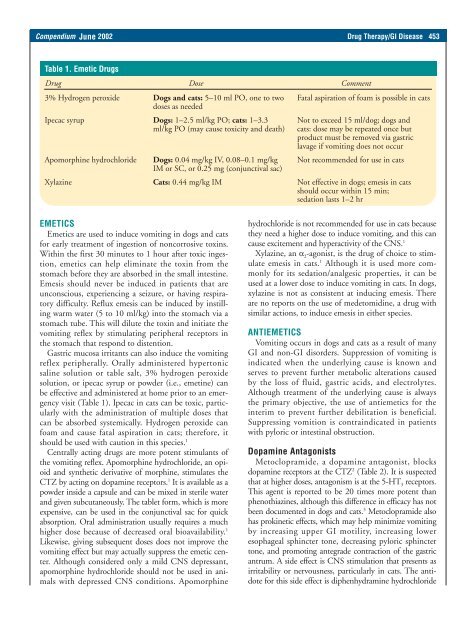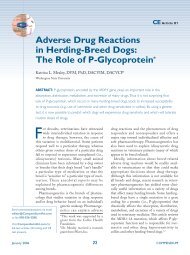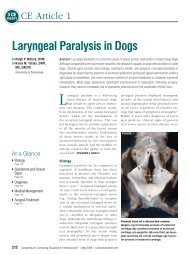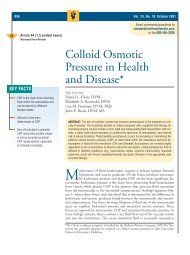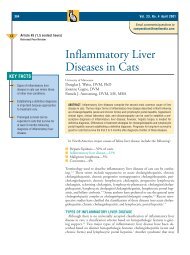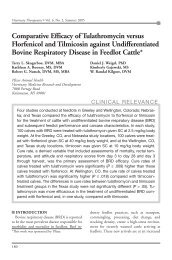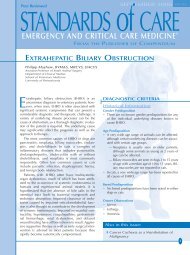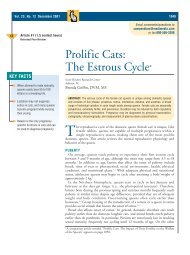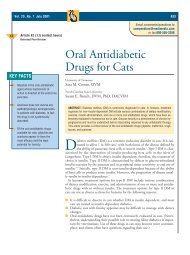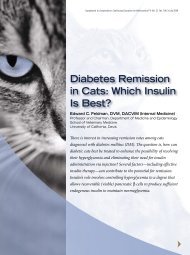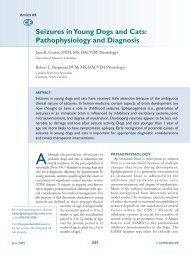Create successful ePaper yourself
Turn your PDF publications into a flip-book with our unique Google optimized e-Paper software.
Compendium June 2002 Drug Therapy/GI Disease 453<br />
Table 1. Emetic Drugs<br />
Drug Dose Comment<br />
3% Hydrogen peroxide Dogs and cats: 5–10 ml PO, one to two<br />
doses as needed<br />
Fatal aspiration of foam is possible in cats<br />
Ipecac syrup Dogs: 1–2.5 ml/kg PO; cats: 1–3.3 Not to ex<strong>ce</strong>ed 15 ml/dog; dogs and<br />
ml/kg PO (may cause toxicity and death) cats: dose may be repeated on<strong>ce</strong> but<br />
product must be removed via gastric<br />
lavage if vomiting does not occur<br />
Apomorphine hydrochloride Dogs: 0.04 mg/kg IV, 0.08–0.1 mg/kg<br />
IM or SC, or 0.25 mg (conjunctival sac)<br />
Not re<strong>com</strong>mended for use in cats<br />
Xylazine Cats: 0.44 mg/kg IM Not effective in dogs; emesis in cats<br />
should occur within 15 min;<br />
sedation lasts 1–2 hr<br />
EMETICS<br />
Emetics are used to indu<strong>ce</strong> vomiting in dogs and cats<br />
for early treatment of ingestion of noncorrosive toxins.<br />
Within the first 30 minutes to 1 hour after toxic ingestion,<br />
emetics can help eliminate the toxin from the<br />
stomach before they are absorbed in the small in<strong>test</strong>ine.<br />
Emesis should never be indu<strong>ce</strong>d in patients that are<br />
unconscious, experiencing a seizure, or having respiratory<br />
difficulty. Reflux emesis can be indu<strong>ce</strong>d by instilling<br />
warm water (5 to 10 ml/kg) into the stomach via a<br />
stomach tube. This will dilute the toxin and initiate the<br />
vomiting reflex by stimulating peripheral re<strong>ce</strong>ptors in<br />
the stomach that respond to distention.<br />
Gastric mucosa irritants can also indu<strong>ce</strong> the vomiting<br />
reflex peripherally. Orally administered hypertonic<br />
saline solution or table salt, 3% hydrogen peroxide<br />
solution, or ipecac syrup or powder (i.e., emetine) can<br />
be effective and administered at home prior to an emergency<br />
visit (Table 1). Ipecac in cats can be toxic, particularly<br />
with the administration of multiple doses that<br />
can be absorbed systemically. Hydrogen peroxide can<br />
foam and cause fatal aspiration in cats; therefore, it<br />
should be used with caution in this species. 1<br />
Centrally acting drugs are more potent stimulants of<br />
the vomiting reflex. Apomorphine hydrochloride, an opioid<br />
and synthetic derivative of morphine, stimulates the<br />
CTZ by acting on dopamine re<strong>ce</strong>ptors. 1 It is available as a<br />
powder inside a capsule and can be mixed in sterile water<br />
and given subcutaneously. The tablet form, which is more<br />
expensive, can be used in the conjunctival sac for quick<br />
absorption. Oral administration usually requires a much<br />
higher dose because of decreased oral bioavailability. 1<br />
Likewise, giving subsequent doses does not improve the<br />
vomiting effect but may actually suppress the emetic <strong>ce</strong>nter.<br />
Although considered only a mild CNS depressant,<br />
apomorphine hydrochloride should not be used in animals<br />
with depressed CNS conditions. Apomorphine<br />
hydrochloride is not re<strong>com</strong>mended for use in cats because<br />
they need a higher dose to indu<strong>ce</strong> vomiting, and this can<br />
cause excitement and hyperactivity of the CNS. 1<br />
Xylazine, an α 2-agonist, is the drug of choi<strong>ce</strong> to stimulate<br />
emesis in cats. 1 Although it is used more <strong>com</strong>monly<br />
for its sedation/analgesic properties, it can be<br />
used at a lower dose to indu<strong>ce</strong> vomiting in cats. In dogs,<br />
xylazine is not as consistent at inducing emesis. There<br />
are no reports on the use of medetomidine, a drug with<br />
similar actions, to indu<strong>ce</strong> emesis in either species.<br />
ANTIEMETICS<br />
Vomiting occurs in dogs and cats as a result of many<br />
GI and non-GI disorders. Suppression of vomiting is<br />
indicated when the underlying cause is known and<br />
serves to prevent further metabolic alterations caused<br />
by the loss of fluid, gastric acids, and electrolytes.<br />
Although treatment of the underlying cause is always<br />
the primary objective, the use of antiemetics for the<br />
interim to prevent further debilitation is beneficial.<br />
Suppressing vomition is contraindicated in patients<br />
with pyloric or in<strong>test</strong>inal obstruction.<br />
Dopamine Antagonists<br />
Metoclopramide, a dopamine antagonist, blocks<br />
dopamine re<strong>ce</strong>ptors at the CTZ 2 (Table 2). It is suspected<br />
that at higher doses, antagonism is at the 5-HT 3 re<strong>ce</strong>ptors.<br />
This agent is reported to be 20 times more potent than<br />
phenothiazines, although this differen<strong>ce</strong> in efficacy has not<br />
been documented in dogs and cats. 3 Metoclopramide also<br />
has prokinetic effects, which may help minimize vomiting<br />
by increasing upper GI motility, increasing lower<br />
esophageal sphincter tone, decreasing pyloric sphincter<br />
tone, and promoting antegrade contraction of the gastric<br />
antrum. A side effect is CNS stimulation that presents as<br />
irritability or nervousness, particularly in cats. The antidote<br />
for this side effect is diphenhydramine hydrochloride


